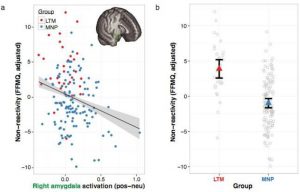Reduce Aggression with Mindfulness
By John M. de Castro, Ph.D.
“young adults who participated in an app-based meditation training were less aggressive after receiving critical feedback, but not less angry. It suggests that being mindful doesn’t interfere with experiencing emotions, but changes how one responds to them.” – AMRA
The human tendency to lash out with aggression when threatened was adaptive for the evolution of the species. It helped promote the survival of the individual, the family, and the tribe. In the modern world, however, this trait has become more of a problem than an asset. It results in individual violence and aggression such as physical abuse, fights, road rage, and even murders, and in societal violence such as warfare. It may even be the basis for the horrors of terrorism and mass murder. Obviously, there is a need in modern society to control these violent and aggressive urges.
Aggression may, at least in part, be amplified by anger rumination; an uncontrollable, repetitive thinking about anger and its sources. This can produce a downward spiral where people repeatedly think about their anger which, in turn, reinforces the anger making it worse and worse. It is like a record that’s stuck and keeps repeating the same lyrics. It’s replaying a dispute in the individual’s mind. It’s going over their anger, again and again. Fortunately, rumination may be interrupted by mindfulness and mindfulness may improve the individual’s ability to regulate their emotions. This may, in part, be a mechanism by which mindfulness training reduces aggression and hostility. Hence, mindfulness may be an antidote to violent and aggressive urges by interrupting anger rumination and improving emotion regulation.
In today’s Research News article “Emotion regulation mediates relationships between mindfulness facets and aggression dimensions.” (See summary below or view the full text of the study at: https://www.ncbi.nlm.nih.gov/pmc/articles/PMC6916265/), Garofalo and colleagues recruited adult prisoners and a community sample of adult nonoffenders. They then had them complete measures of mindfulness, emotion regulation, and aggressiveness.
Correlational analysis revealed that in both the offender and nonoffender samples, the higher the levels of mindfulness, the higher the levels of emotion regulation and the lower the levels of aggressiveness. In addition, the higher the levels of emotion regulation the lower the levels of aggressiveness. Further, structural equation modelling revealed that in both the offender and nonoffender samples that emotion regulation mediated the relationship between mindfulness and aggressiveness. That is, the mindfulness was not associated with aggressiveness directly but rather mindfulness was associated with higher levels of emotion regulation which, in turn, was associated with lower levels of aggressiveness.
These findings are correlational and as such causation cannot be determined. But, prior research has shown a causal connection between mindfulness and higher levels of emotion regulation and that emotion regulation has a causal connection to lower aggressiveness and that mindfulness has a causal connection to lower aggressiveness. So, it is likely that the present findings are the results of causal links between mindfulness, emotion regulation, and aggressiveness.
Hence, the present results suggest that being mindful goes along with having better ability to regulate emotions and that goes along with less aggressiveness. Emotion regulation is not suppression of emotions rather it is the ability to feel the emotions but not let them dictate behavior; feeling emotions but remaining in control. Thus, the results suggest that aggressiveness may result from uncontrolled reactions to emotions and that mindfulness by improving emotion regulation reduces these responses.
It is interesting that the results were exactly the same for both prisoners and nonoffender adults. This suggests that there is nothing special about the mechanisms controlling aggressiveness in prisoners. Rather it would appear that prisoners have a lower level of emotion regulation. This implies that improving mindfulness and emotion regulation in prisoners would lead to greater control and less violence and aggression.
So, reduce aggression in with mindfulness.
“When any emotion rises up, we tend to first get caught up in it and then act it out, through speech or action. This couldn’t be truer for the heightened emotion of anger. Meditation, though, can teach us how to change a rash, reactive mindset into a more considered, responsive, and productive one.” – Headspace
CMCS – Center for Mindfulness and Contemplative Studies
This and other Contemplative Studies posts are also available on Google+ https://plus.google.com/106784388191201299496/posts and on Twitter @MindfulResearch
Study Summary
Garofalo, C., Gillespie, S. M., & Velotti, P. (2020). Emotion regulation mediates relationships between mindfulness facets and aggression dimensions. Aggressive behavior, 46(1), 60–71. doi:10.1002/ab.21868
Abstract
Recent years have witnessed an increase of research on socio‐affective factors that can explain individual differences in aggressive tendencies across community and offender populations. Specifically, mindfulness and emotion regulation have emerged as important factors, which could also constitute important prevention and treatment targets. Yet, recent studies have advanced the possibility that mindfulness may also have a “dark” side, being associated with increased levels of aggression‐related variables, especially when accounting for the variance associated with emotion regulation. The present study sought to elucidate relationships among mindfulness, emotion regulation, and aggression dimensions (i.e., verbal and physical aggression, anger, and hostility) across violent offender (N = 397) and community (N = 324) samples. Results revealed expected associations between both mindfulness and emotion regulation and aggression dimensions, such that greater impairments in mindfulness and emotion regulation were related to increased levels of aggression across samples. Further, analyses of indirect effects revealed that a latent emotion dysregulation factor accounted for (i.e., mediated) relationships between mindfulness facets and aggression dimensions in both samples. Previously reported positive associations between the residual variance in mindfulness scales (i.e., controlling for emotion regulation) and aggression‐related variables were not replicated in the current samples. Taken together, findings suggest that mindfulness and emotion regulation have unequivocal relations with lower levels of aggression, and should therefore be considered as relevant targets for prevention and treatment programs aimed at reducing aggressive tendencies.
https://www.ncbi.nlm.nih.gov/pmc/articles/PMC6916265/









